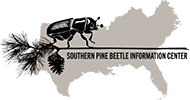Abstract
In coming decades, warmer winters are likely to ease range constraints on many cold-limited forest insects. Recent unprecedented expansion of the southern pine beetle (SPB, Dendroctonus frontalis) into New Jersey, New York, and Connecticut in concert with warming annual temperature minima highlights the risk that this insect pest poses to the pine forests of the northern United States and Canada under continued climate change. Here we present projections of northward expansion in SPB-suitable climates using a statistical bioclimatic range modeling approach and current-generation general circulation model (GCM) output under the Representative Concentration Pathway (RCP) 4.5 and 8.5 emissions scenarios. Our results show that by the middle of the 21st century, the climate is likely to be suitable for SPB expansion into vast areas of previously unaffected forests throughout the northeastern United States and into southeastern Canada. This scenario would pose a significant economic and ecological risk to the affected regions, including disruption of local ecosystem services, shifts in forest structure, and threats to native biodiversity.
SPB is a major forest pest in the southeastern United States responsible for 14 million m3 of timber losses worth an estimated US$1.7 billion over 1990–2004. SPB has historically been most damaging in southeastern states, with limited activity in the northern portion of its range including Ohio, Pennsylvania, and Maryland. However, SPB outbreaks have become increasingly problematic and extensive in southern New Jersey since 2001, and populations have been detected for the first time on Long Island, New York, in 2014 and in Connecticut in 2015.
To read the full article please visit the link below:
Lesk, Corey, Ethan Coffel, Anthony W. D’Amato, Kevin Dodds, and Radley Horton. 2017. “Threats to North American Forests from Southern Pine Beetle with Warming Winters.” Nature Climate Change 7 (10): 713-+. https://doi.org/10.1038/NCLIMATE3375.
